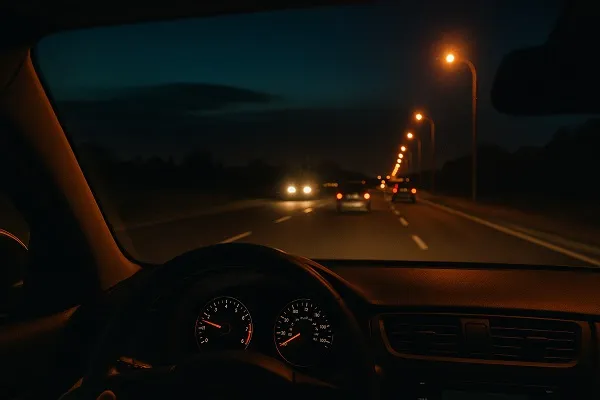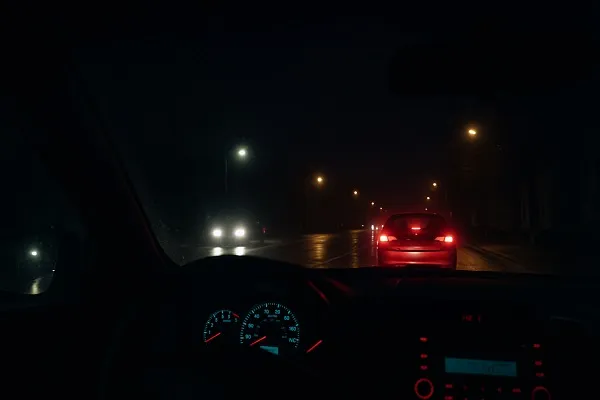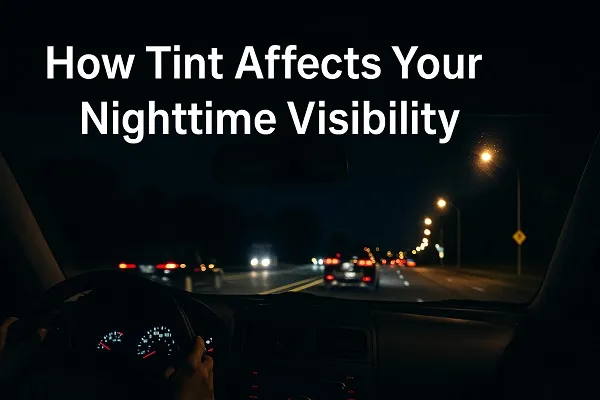When it comes to driving after dark, the way tint affects your nighttime visibility can play a major role in comfort, safety, and performance. While window tinting is often chosen for privacy, UV protection, and heat reduction, its impact on visibility at night is equally important to consider.
The Science Behind Nighttime Light and Tint
Driving visibility at night is already reduced due to limited light. Adding tint changes how much light passes through your windows, which directly affects how clearly you can see.
- Reduced Light Transmission: Even a legal tint limits the amount of visible light entering your vehicle. At night, when light levels are already low, this can make objects harder to see.
- Contrast Reduction: Tint can reduce the contrast between shadows and lit areas, making pedestrians, animals, or debris on the road less noticeable.
- Color Perception: Some tints can slightly alter how your eyes perceive colors, which may affect how quickly you recognize brake lights or road signs.
Types of Tint and Their Effect on Visibility
Not all tints affect night driving equally. The type of film you choose determines how much light is allowed in and how much visibility is retained.
- Dyed Window Tint: Often the darkest, dyed films can significantly limit nighttime clarity.
- Metalized Tint: Provides heat reduction but can increase glare from oncoming headlights.
- Ceramic Tint: Allows higher light transmission while still blocking UV rays, making it one of the better options for nighttime driving.
Legal Limits and Safety Considerations
Every state has its own laws regarding tint darkness, often measured as Visible Light Transmission (VLT). Going below legal limits can make nighttime driving unnecessarily risky.
- Check State Laws: Many states require at least 35% VLT on front windows.
- Inspection Risks: Too-dark tints can lead to failed inspections or fines.
- Insurance Factors: If tint contributes to an accident, it could affect liability.
Practical Effects While Driving at Night

Tint affects more than just how clearly you see through your windshield. Different conditions reveal its impact in unique ways.
Street Lighting and Rural Roads
- In brightly lit urban areas, tint may have less effect since streetlights compensate for reduced light transmission.
- On rural or poorly lit roads, darker tint can create blind spots and limit reaction time.
Oncoming Headlight Glare
- A moderate tint can actually reduce glare from bright headlights.
- However, too dark a tint makes it difficult to distinguish between headlight beams and surrounding road details.
Peripheral Awareness
Tint on side windows may reduce your ability to spot cyclists, pedestrians, or animals approaching from the sides.
Tips for Balancing Tint and Visibility
If you want the benefits of tinted windows without compromising nighttime visibility, consider the following strategies:
- Choose Lighter Tint for Front Windows: Keep the darkest tint for rear windows where it has less effect on driving.
- Select High-Quality Film: Ceramic and hybrid films allow better visibility while still blocking heat and UV rays.
- Regular Cleaning: Dirt and streaks are amplified at night; clean windows improve clarity.
- Pair With Proper Headlights: Ensure headlights are properly aligned and bright enough to offset reduced visibility.
- Anti-Reflective Glass Treatments: These can help reduce glare and improve sharpness at night.
Myths About Tint and Night Driving
There are several misconceptions about tint and nighttime driving that are worth clearing up:
- “Darker Tint Improves Night Vision”: False. While it can reduce glare, it also reduces overall visibility.
- “Any Tint Is Dangerous at Night”: Not true. Light, high-quality tint can provide benefits without major drawbacks.
- “Rear Windows Don’t Matter”: They do—especially when backing up or checking blind spots.
When Tint Becomes a Hazard

In some cases, tint can become more of a safety risk than an enhancement. Signs your tint is too dark for nighttime use include:
- Difficulty seeing pedestrians or animals until you’re very close.
- Trouble reading reflective road signs.
- Frequent strain on your eyes after extended night driving.
- Needing to lower side windows to make lane changes safely.
Safe Alternatives to Dark Tint
If privacy or glare reduction is your main goal, but you’re concerned about nighttime visibility, alternatives exist:
- Light Tint with UV Protection: Offers daytime comfort without sacrificing nighttime safety.
- Photochromic Films: Adjusts tint level depending on light exposure.
- Visors and Polarized Sunglasses (Day Use Only): Help reduce glare without impacting nighttime clarity.
Making an informed decision about how tint affects your nighttime visibility ensures you get the comfort and protection you want without compromising safety. The right balance allows you to enjoy tinted windows while still seeing clearly in low-light conditions.

